Physical Address
304 North Cardinal St.
Dorchester Center, MA 02124
Elbow, wrist, and hand surgery are frequently done to repair bone and soft tissues, such as fractures and disruptions of ligaments and tendons. Nerves also traverse the area and are released from various tunnels. In this chapter, common indications are discussed for surgery on various bone and soft tissue structures in and around these joints, and some of the procedures with their postoperative imaging appearances are described.
The ulnar collateral ligament (UCL) complex is composed of an anterior, a posterior, and a transverse bundle. Although the entire complex is charged with providing valgus stability to the elbow, it is the anterior bundle that has been shown to be the most important stabilizer against valgus stress at the joint from 30 to 120 degrees of flexion. Interestingly, a single acute traumatic episode to this ligament rarely leads to symptomatic instability in the majority of those injured. Rather, it is chronic repetitive microtrauma with recurrent valgus stress at the medial elbow, such as that encountered in the overhead throwing athlete, that has been implicated in symptomatic valgus instability. It is the near-failure tensile stress encountered in the overhead throwing motion that results in the injury to the UCL and the need to expose an injured ligament to this stress that forms the basis for two of the indications for surgical management. These include (1) throwing athletes with a complete UCL tear, (2) partial tears that have failed rehabilitation, and (3) symptomatic nonthrowing athletes after a minimum of 3 months of rehabilitation
There are six phases of throwing: wind up, early cocking, late cocking, acceleration, deceleration, and follow through. It is the combination of large valgus loads initiated in the late cocking phase with the rapid elbow extension generated in acceleration that produces compression overload laterally, sheer stress in the posterior compartment, and tensile overload medially. This phenomenon, termed valgus extension overload syndrome, forms the basic pathophysiologic model behind most common elbow injuries in the overhead throwing athlete, including ulnar collateral ligament (UCL) injury. This concept, although incompletely developed, was introduced in the literature in the late 1960s and was termed medial elbow-stress syndrome . This marked the advent of a heightened awareness and new understanding of the pathophysiology of a major cause of elbow pain in the overhead throwing athlete, one that would clearly require operative treatment for a successful outcome.
In 1974, the first UCL reconstruction was performed by Dr. Frank Jobe, who gave his patient Tommy John (a Los Angeles Dodgers pitcher) a 1% chance of avoiding retirement with the intervention. Tommy John returned to baseball 2 years later, and the successful procedure revolutionized the treatment of UCL reconstruction.
Although early studies advocated primary repair of UCL injuries, the applicability of these studies to current patient populations is limited because they did not include high performance athletes or document the type or level of sports involvement. Numerous recent studies have concluded that UCL reconstruction is more effective than primary repair in correcting medial elbow instability and returning overhead throwing athletes to a pre-injury level of play in less than 1 year, the measure of a successful procedure.
Since the first UCL reconstruction was performed, a variety of modifications have been adapted to this type of surgery. This includes the figure-of-eight repair, muscle splitting modification, American Sports Medicine Institute's modification, suture anchor method, docking technique, and interference technique.
The original UCL reconstruction was performed by Jobe and colleagues. The ligament was exposed by detaching and elevating the flexor-pronator muscle mass from the medial epicondyle of the humerus. A submuscular ulnar nerve transposition was performed. The anterior bundle of the UCL was reconstructed with a harvested autograft (palmaris longus) in a figure-of-eight fashion through two drill holes in the ulna and three in the medial epicondyle ( eFig. 108-1 ). The posterior cortex of the humerus was penetrated, and the graft was sutured to itself.
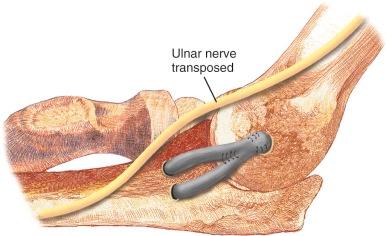
At 2-year follow-up, 63% of elite throwing athletes returned to a pre-injury level of throwing for at least 1 year. Despite the ground-breaking success of this procedure, the rate of complication was 31%. Postoperative dysfunction of the ulnar nerve was the most commonly cited complication, often requiring decompression. Similar results were seen in a subsequent larger study group with 68% of elite throwing athletes returning to a pre-injury level of throwing for at least 1 year. In this group, postoperative ulnar nerve dysfunction occurred in 21% of patients, several of whom required revision decompression of the ulnar nerve. These results prompted the development of surgical modifications to simplify the technique, evade dissection and detachment of the flexor-pronator mass, and limit handling of the ulnar nerve.
In 1996, Smith and colleagues described the safe zone of the medial elbow. This zone refers to an internervous plane of exposure to the medial ulnohumeral articulation that extends from the medial epicondyle to 1 cm distal to the insertion of the UCL on the sublime tubercle of the ulna. It is between the median and ulnar nerve sites of innervation of surrounding muscles. Rather than completely detach the flexor-pronator mass from the medial epicondyle, the muscle group was split along its safe zone, through the posterior third of the common flexor bundle (the most anterior fibers of the flexor carpi ulnaris), to access the joint and perform the ligament reconstruction using Jobe's original technique. This modified technique also obviated the need to transpose the ulnar nerve.
At 2-year follow-up, 82% of elite overhead throwing athletes returned to play. In athletes without prior surgery, this number increased to 93%. In the immediate postoperative period, only 5% of the patients had transient ulnar nerve problems. All resolved without surgery.
Andrews and colleagues modified Jobe's original technique by retracting the flexor carpi ulnaris anteriorly and by performing a subcutaneous rather than submuscular nerve transposition. In a large retrospective review comparing primary ligament repair with this modified technique, 79% of patients undergoing reconstruction returned to a pre-injury level of play on an average of 9.8 months after surgery. In comparison, only 63% of patients treated with direct repair returned to the same level of sport. Only one of the patients with ligament reconstruction developed transient postoperative ulnar nerve changes. Moreover, 9 of 10 patients who had preoperative ulnar neuritis experienced resolution of symptoms.
In the mid-1990s, suture anchors were introduced into the UCL reconstruction techniques in an attempt at further simplifying the procedure. A cadaveric study by Hechtman and colleagues compared the suture anchor and bone tunnel techniques in 31 cadaveric specimens (15 underwent reconstruction with bone tunnels, 16 with suture anchors). The strength of each reconstruction was compared with the original strength of the ligament. Results of this study showed that there was no significant difference in reconstruction strength between the suture anchor (76.3%) and the bone tunnel (63.9%) techniques. Both methods produced reconstructions that were significantly weaker than a native UCL. It was apparent, however, that the suture anchor technique reproduced normal UCL anatomy and mechanical function more closely than bone tunnels. Despite the apparent success of this cadaveric work, the technique fell out of use when clinical applications yielded a failure rate of 30%.
In 1996, Rohrbough and colleagues implemented a muscle-splitting approach to modify the UCL reconstruction in a technique, called the docking procedure ( eFig 108-2 ). Unlike Jobe's technique, in which the graft is placed in a figure-of-eight position, in this technique, the graft is placed in a triangular configuration through a single humeral tunnel, and the limbs are brought out through separate bone tunnels and tied over a bone bridge. It has been suggested that the docking technique allows for better tensioning of the ligament graft. In an uncontrolled retrospective review by Rohrbough and colleagues, 92% of patients returned to a pre-injury level of play for at least 1 year. No complications were reported.
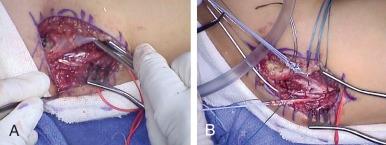
Ochi and colleagues described an interference technique for fixation of the UCL graft. The goal was to reconstruct the central isometric fibers of the native UCL, which lie between the anterior one third and the posterior two thirds of the anterior bundle of the UCL. Through the muscle-splitting approach, grafts are fixed with interference screws placed in single bony tunnels in the humerus and ulna. Unlike Jobe's original technique, only two bone tunnels are needed. The ulnar nerve is less at risk. Likewise, without an intervening bony bridge on the ulna, the risk of tunnel fractures between the two tunnels is theoretically eliminated.
The biomechanical results of this technique have been mixed. In a cadaveric study comparing intact with reconstructed elbows using the interference technique, the normal elbow kinematics were restored with the interference fixation. The failure strength of the UCL reconstruction with interference fixation was reported to be similar to that of the native intact UCL. In this study, the ligament was loaded once to failure. However, in a study in which a cyclic loading protocol is used to better replicate the clinical mechanism of injury, this technique as well as other reconstruction techniques showed reconstruction failure at significantly lower loads than the normal intact ligament.
Stress radiographs are limited for examination of the ulnar collateral ligament. Sometimes, they are normal in the presence of a rupture. CT arthrography is also limited. The reconstructed ligament is continuous and water tight, as demonstrated on MR arthrography ( Fig. 108-1 ). The integrity of the ligament can be assessed with MRI, MR arthrography, or ultrasound. On MRI performed in the early stages, the ligament may demonstrate high signal intensity within its substance related to suture material and granulation tissue. With time (approximately 6 months), the normal ligament decreases in signal intensity on all imaging sequences, and it may be thickened ( Fig. 108-2 ). Most of the time, the reconstructed ligament is low signal intensity on all imaging sequences. In one study, approximately 25% of ligament reconstructions were intermediate signal intensity, especially proximally. There are often tunneling defects in the distal humerus and proximal ulna. The distal portion of the graft may enter the ulna at a slightly more distant location, up to 4 mm below the sublime tubercle. This should be considered a normal finding if the tunnel is next to that insertion and should not be mistaken for a partial tear (T sign) (see eFig. 108-3 ). Metal anchors and screws may be present. These metallic devices could interfere with assessment of the ligament on MRI ( Fig. 108-3 ). Metal reduction techniques, such as increasing bandwidth, avoiding fat-suppression and gradient-echo techniques, and using lower magnetic field strength, aid in the evaluation of the ligament reconstruction. The ulnar nerve may have been transposed from the cubital tunnel and placed in a submuscular or subcutaneous location. One should assess the nerve signal and size related to itself in other locations or to other nerves around the elbow to determine whether it is abnormal.
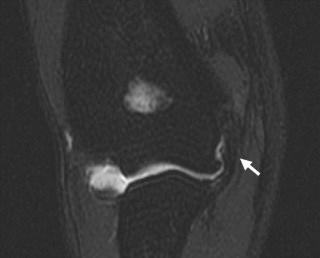
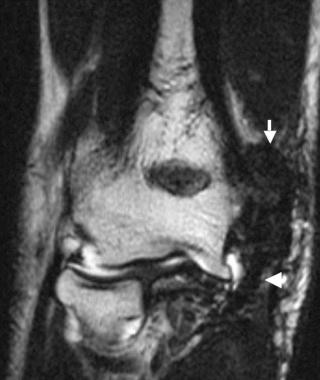
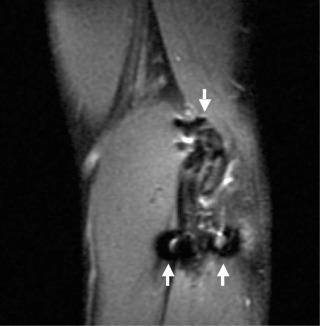
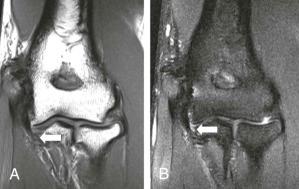
The success rates of reconstruction vary between 63% and 97%, depending on the technique. Reported complication rates are less than 10%. Despite the variability in techniques, the unifying features are that decreased dissection of the flexor-pronator mass and decreased handling of the ulnar nerve lead to improved outcomes.
As noted previously, four UCL reconstruction techniques have been compared biomechanically (docking, interference screw fixation, figure-of-eight, and single-stranded UCL reconstruction using an EndoButton [Smith & Nephew, London, England] for ulnar fixation). Cadaveric specimens were subjected to pneumatic cyclic valgus loading. All techniques showed significantly lower peak load to failure than the intact native ligament. No difference in strength was found between the docking and single-stranded UCL reconstruction using EndoButton fixation. Both of these techniques were stronger than the interference screw or figure-of-eight techniques.
For the 20 intact specimens in the study, complete disruption of the ligament occurred at the humeral attachment in 9 specimens, the ulnar attachment in 4, and the midsubstance of the anterior bundle of the medial collateral ligament in 2. In the remaining five specimens, the joint gapped 5 mm without complete visual disruption of the ligament. In the reconstruction, no complete disruption occurred for any technique. For the docking, EndoButton, and figure-of-eight procedures, the mode of failure was the suture pulling out of the suture/ligament interface. For the interference screw reconstruction, the tendon pulled out at the tendon/screw interface.
Regarding visualization of complications on imaging, one should evaluate the elbow for abnormal valgus angulation and dislodgement of hardware on radiographs, ultrasonography, and MRI. MR arthrography is particularly helpful for assessment of the reconstructed UCL. The tendon or graft should be assessed for discontinuity, laxity, thinning, and irregularity. A completely disrupted graft will show a full thickness defect on ultrasound, high signal intensity on T2-weighting on MRI, and contrast extension through the graft into surrounding soft tissues on CT and MR arthrography. CT and MR arthrography are also helpful for outlining the undersurface of the ligament for irregularity or laxity related to partial tears. Median, radial, and ulnar nerve injury is a complication of elbow surgery due to laceration or compression. Heterotopic ossification may be seen in the ligament or surrounding soft tissues. An avulsion fracture of the medial epicondyle is a rare complication. One should look for other postoperative changes, such as excessive scar tissue, infection, synovial fistula formation, and instruments or other hardware left in the joint.
The lateral collateral ligament (LCL) complex consists of four components: annular ligament, radial collateral ligament, lateral ulnar collateral ligament (LUCL), and accessory annular ligament. The ligament complex originates from the undersurface of the lateral epicondyle at a point through which the center of rotation passes. Therefore, it is isometric throughout the normal range of flexion and extension. The radial collateral ligament has a distal point of attachment on the annular ligament, stabilizing the proximal radioulnar joint. The LUCL also attaches to the annular ligament but has a point of attachment distally at the supinator crest of the ulna. Because this ligament crosses the articulation and has both a proximal and distal osseous attachment, it is considered to be a major stabilizer of the lateral elbow. In 1991, O'Driscoll and colleagues first described posterolateral rotatory instability of the elbow. The cause for this condition was thought to be a laxity of the LUCL allowing a transient rotatory subluxation of the ulnohumeral joint and a secondary dislocation of the radiocapitellar joint. Ordinarily, the LCL complex maintains these joints in a reduced position. A mechanism for elbow subluxation and dislocation was then described in which there was increasing ligamentous and capsular damage progressing from lateral to medial across the joint. Dislocation was the final of three sequential stages of elbow instability resulting from posterolateral rotation.
Most patients with lateral elbow instability present with symptoms after an elbow dislocation. Less commonly, there is a history of surgery to the lateral side of the elbow. Although most studies indicate that both medial and lateral collateral ligament (LCL) complexes are disrupted after dislocation, residual instability more commonly involves the lateral side. The clinical presentation is quite variable, although patients often present with a history of recurrent painful clicking, catching, or snapping of the elbow. Symptoms typically occur in the extension portion of the motion arc with the forearm in supination. The classic activity that reproduces a patient's symptoms is pushing down on the armrest when rising from a chair. The physical examination may be unremarkable. The classic physical examination finding is that of a positive pivot shift maneuver. The elbow is supinated by applying torque at the wrist, and a valgus moment is applied to the elbow during flexion. This action results in a typical apprehension response with reproduction of the patient's symptoms and a sense that the elbow is about to dislocate. Reproducing the actual subluxation and the clunk that occurs with reduction can usually be accomplished only with the patient under general anesthesia.
Indications for surgical treatment of the LCL complex include patients with symptomatic instability. Reconstruction of the LCL complex has been recommended to restore stability of the elbow in patients with posterolateral rotatory instability. Although there are no absolute contraindications to surgical treatment, there are relative ones. Children with open epiphyseal plates should not have their ligaments reconstructed with tendon grafts across the physis. Instead, the existing LCL tissues are imbricated and reattached to bone isometrically. The absence of a radial head adversely affects the prognosis of surgical therapy but is not a contraindication. Currently, acute ligament repair is recommended only for gross instability after reduction of the elbow or in conjunction with open reduction of fracture-dislocations. This is particularly indicated when there has been internal fixation of the radial head and/or coronoid process. Surgery consists of either primary repair or reconstruction with a tendon graft.
Sanchez-Sotelo and colleagues reported that reconstruction using a tendon graft seemed to provide better results than ligament repair for the treatment of posterolateral rotatory instability of the elbow. Osborne and Cotterill first described repair of the lateral capsuloligamentous structures of the elbow for recurrent dislocation. In such cases, the ligamentous and muscular origins have usually been avulsed from the lateral epicondyle and can be repaired directly back down to bone, thereby reestablishing lateral elbow stability. Most authors believe that acute ligament repairs should be augmented with a heavy suture along the course of the lateral ulnar collateral ligament. This serves to stress-shield the repair during the early postoperative period. The LCL complex can also be augmented using three fan-shaped arcades of suture secured through holes drilled in the lateral epicondyle. The first arcade follows the path of the lateral ulnar collateral ligament, the second follows the path of the LCL and engages the annular ligament, and the third engages the posterior capsule and anconeus muscle.
Although there is little in the way of long-term results of this treatment, the procedure appears successful. O'Driscoll and colleagues briefly mention results in five patients in their initial description of the posterolateral rotatory instability of the elbow. In 1992, Nestor and colleagues reported results of LCL complex reconstruction in 11 patients with an average of 42 months' follow-up. Stability was obtained in 10 patients, 7 of whom had an excellent functional result. The four patients with less than excellent results had had previous surgery. If the radial head has been excised or there is degenerative change in the joint, the satisfactory result decreases, although stability is usually achieved. More recently, Sanchez-Sotelo and colleagues described the intermediate results of lateral ligamentous reconstruction for posterolateral rotatory instability of the elbow. Surgery restored stability in all, except in five patients. In two of the five, the elbow became stable after a second procedure. Better results were obtained in patients with a posttraumatic etiology, subjective symptoms of instability at presentation, and those who had an augmented reconstruction using a tendon graft.
Most LCL complex reconstructions use the technique introduced by O'Driscoll and colleagues, or some modification of it. This technique begins with a 10-cm incision between the epicondyle and olecranon. The deep fascia is incised along the supracondylar ridge and distally between the anconeus and extensor carpi ulnaris muscles. The triceps and anconeus are reflected in continuity off of the posterior humerus and capsule, exposing the lateral side of the ulna. The common extensor origin is partially reflected to expose the capsule. Capsuloligamentous attenuation is assessed and laxity confirmed. The capsule is opened along the capitellum in an arc to permit inspection of the joint and later imbrication of the capsule. The insertion site for the tendon graft is then prepared by creating two drill holes in the ulna, one near the tubercle on the supinator crest and the other 1.25 cm proximally at the base of the annular ligament. The underlying bone is channeled. Suture is passed through the holes, and the isometric ligament insertion is determined by flexing and extending the elbow to see if the suture moves. No movement occurs when suture and hemostat are on the isometric point. A hole for the graft entry site on the humerus is then created. If the hole is placed distally or posteriorly, the graft will be lax in extension and tight in flexion. An exit for the graft is created just posteriorly to the supracondylar ridge about 1.5 cm proximally with a tunnel extending between the entry and exit sites. A third and final hole is placed in the distal humerus and is referred to as the reentry site. It is located just posterior to the initial entry site hole, and a tunnel will extend between it and the entry site. The graft will pass through this tunnel and will be sutured to itself at the entry site.
On MRI and ultrasound, the reconstructed radial collateral ligament should be continuous after primary repair or graft reconstruction. It will be heterogeneous in signal intensity, at first, but should decrease in signal intensity with time (see eFig. 108-4 ). It may be helpful to see this ligament using the 20-degree posterior oblique axis with regard to the elbow joint from a sagittal scout image.
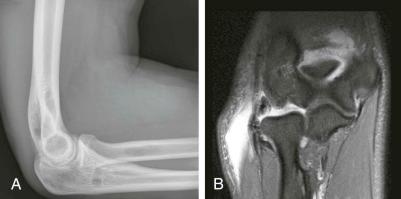
Delayed laxity, recurrent dislocation, and reinjury have been observed after LCL complex reconstruction ( Fig. 108-4 ; see also eFig. 108-5 ). Complications associated with graft harvesting are possible. Iatrogenic fracture of the osseous tunnels can occur but are generally not problematic with careful surgical technique. Mild flexion contracture can be accepted as the most vulnerable position of instability in full extension. Heterotopic ossification may form around the elbow following surgery. As always, infection is also a possible complication of surgery ( Fig. 108-5 ).
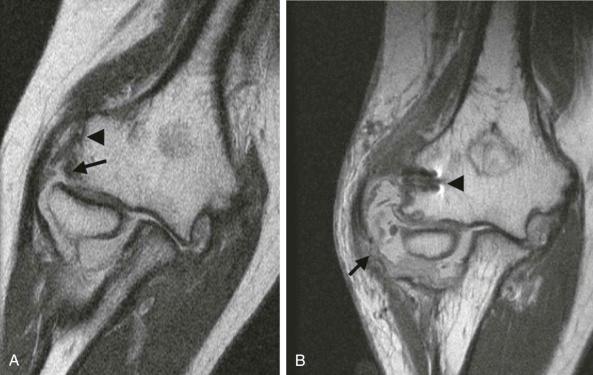
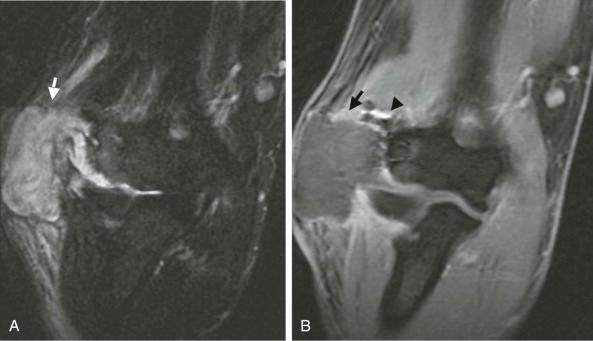

Ulnar nerve entrapment at the elbow is the second most common peripheral nerve compression neuropathy. At the level of the elbow, the ulnar nerve is housed in the cubital tunnel. The cubital tunnel is a fibro-osseous conduit along the posterior aspect of the medial epicondyle. This fibro-osseous space is formed anteriorly by the medial epicondyle and laterally by the medial margin of the trochlea and olecranon. The posterior bundle of the UCL forms the floor of the cubital tunnel, and the arcuate ligament forms the roof. The arcuate ligament may be absent in up to 23% of subjects. Fatty tissue usually surrounds the ulnar nerve and posterior recurrent ulnar artery as they pass through the cubital tunnel.
The ulnar nerve innervates the skin and muscles of the ulnar side of the forearm and hand. This includes the flexor carpi ulnaris and half of the flexor digitorum profundus muscles. Several provocative tests can be used to identify the presence of ulnar nerve compression. Percussion over the ulnar nerve can elicit paresthesias or numbness, resulting in a positive “Tinel” sign. The elbow flexion test is analogous to the Phalen test in diagnosing carpal tunnel syndrome. With the elbow maximally flexed, forearm in supination, and wrist in full extension, patients with cubital tunnel syndrome can experience paresthesia and numbness along the distribution of the nerve. Unfortunately, false-positive results can occur in approximately 10% of normal individuals. Numbness along the small and ulnar half of the ring finger commonly can be due to ulnar nerve compression at the level of the elbow or as the nerve passes Guyon canal. Sensory deficits over the dorsal ulnar aspect of the hand and the dorsum of the small finger can help in determining the level of compression. This area is innervated by the dorsal sensory branch of the ulnar nerve arising proximal to Guyon canal, implying compression at the elbow.
In general, surgical indications include patients with fixed sensory loss, pain, weakness, or significant denervation on electromyography. Patients presenting with transient paresthesia and normal clinical findings are generally managed conservatively with behavioral modification that includes minimizing elbow flexion and prolonged pressure on the elbow.
The clinical evaluation of ulnar nerve entrapment is crucial to guiding treatment, predicting success rates for treatment, as well as assessing post-therapy success. Although it appears that there is no uniformly accepted grading system to evaluate ulnar nerve entrapment, most assessments are based on subjective symptoms, muscle strength, and sensory disturbance. Some very detailed classification systems, such as the Yokohama City University scoring system, also consider the presence of finger deformity.
Not only does the initial clinical assessment of ulnar nerve dysfunction serve as the basis for conservative versus operative treatment, but also it may indicate prognosis. Reports have suggested that prognosis may be more closely related to the level of preoperative damage of nerves and the period between the occurrence and surgery than to surgical methods.
Operative procedures for ulnar nerve entrapment at the elbow can be divided into two groups: decompression with transposition of the ulnar nerve and decompression without transposition of the ulnar nerve. The latter is also referred to as decompression in situ or simple decompression.
The operative procedure for simple decompression was described by Osborne. An 8-cm long curved skin incision is made posteriorly to the medial epicondyle of the humerus. The subcutaneous tissues are dissected, and the nerve is identified. The cubital tunnel retinaculum or arcuate ligament of Osborne is released. This is followed by widening of the entrance to the cubital tunnel between the two heads of the flexor carpi ulnaris muscle.
Those who argue for simple decompression point out the potential for ischemia when the nerve is separated from its primary blood supply. The vascular stripping incurred during transposition may cause a significant decrease in regional blood flow. Animal studies have shown that a devascularized nerve is more susceptible to pressure than a normal nerve. One major aim of the simple decompression is to preserve the vascularity of the nerve. Several studies have compared the simple decompression to anterior submuscular transposition as well as anterior subcutaneous transposition. In general, no statistically significant differences exist between outcomes of the simple decompression versus either transposition method. Because the simple decompression carries less risk of complication, many authors favor it.
Another method to decompress the ulnar nerve includes medial epicondylectomy. This procedure, the modified King's method, consists of a medial epicondylectomy of the humerus with resection of the fibrous band bridging the two heads of the flexor carpi ulnaris (arcuate ligament).
Some advocate the use of a subtotal medial epicondylectomy with resection of 50% of the epicondyle. The advantages of this procedure include removing or releasing all of the compressing structures, creating minimal additional trauma to the nerve with preservation of the native blood supply, and allowing the nerve to follow a course of least resistance. The disadvantages can include bone tenderness at the site of osteotomy, nerve subluxation, flexor-pronator weakness, flexion contracture, and valgus instability. Numerous studies reporting the effectiveness of medial epicondylectomy for cubital tunnel syndrome have been published.
The issue of nerve transposition is a controversial one. It has two main advantages. The first, depending on the cause of the nerve entrapment, is that the nerve may be removed from an unfavorable environment. This may occur when the etiology is scar tissue, fibrosis, or other lesions within the epicondylar groove. The second advantage is that, by transposing the nerve into a new pathway volar to the axis of elbow flexion, the nerve is effectively lengthened, thereby decreasing tension on it. Most authors intuitively agree that the presence of a structural abnormality of the elbow, as noted earlier, or hypermobility of the nerve constitutes good indications for a transposition.
There are three types of anterior transposition: subcutaneous, submuscular, and intramuscular. All are widely used. Subcutaneous transposition is the most commonly used method of ulnar nerve transposition because of its technical ease, high success rate, and low complication rate.
With this procedure, the anterior subcutaneous soft tissues are dissected to form a “bed” for the nerve. The nerve is transposed and retained in the bed with a fascial sling raised from the underlying muscle fascia that is sutured to the dermis. This is an effective procedure, particularly in the elderly and patients who have a thick layer of adipose tissue. The disadvantages are risk of failure to decompress the nerve at the most distal site of the cubital tunnel. In addition, the nerve is most vulnerable to direct trauma after subcutaneous transposition. In one series, unsatisfactory results were reported in up to 15% of cases after this procedure.
Submuscular anterior transposition has become established in the management of chronic ulnar neuropathy, but its success rate in published series has varied considerably. This procedure is generally achieved through a modified Learmonth technique (similar to that described by Kline and colleagues). A curved incision extends from the distal arm to the volar aspect of the medial elbow and into the forearm. The ulnar nerve is identified, and a 360-degree neurolysis is performed at the level of the elbow and distal to the cubital tunnel. A plane of dissection is created on the lateral edge of the pronator teres, taking care to avoid injury to the median nerve. A submuscular plane is created with the median nerve serving as the lateral boundary. The ulnar nerve is transposed into the submuscular bed, and the muscle is subsequently repaired. The advantages of this procedure are that potential sites for nerve compression are definitely explored and released, and the nerve lies in an unscarred anatomic plane not subject to traction forces. This procedure can cause more scarring than others and is usually contraindicated if there is scarring of the joint capsule or distortion of the joint due to arthritis or a malunited fracture. One study comparing submuscular transposition with subcutaneous transposition found that submuscular transposition achieved better results.
Intramuscular transposition is the most controversial of the three methods of ulnar transposition. One study evaluating intramuscular transpositions reported 15% of patients with no improvement.
With simple decompression, the ulnar nerve should be located in the cubital tunnel. If there has been transposition, the ulnar nerve will be repositioned anteriorly between muscles ( Fig. 108-6 ) or in the subcutaneous tissues ( Fig. 108-7 ). In all cases, the size of the ulnar nerve should be normal on MRI and ultrasonography and should not deviate from that above or below the region of surgery. The signal intensity should be intermediate on MRI. With medial epicondylectomy, there will be absence of a portion of the medial epicondyle.
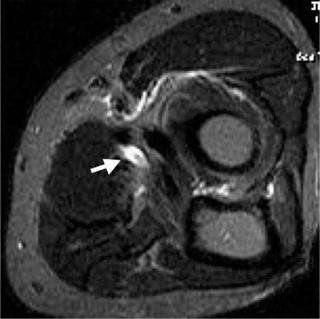
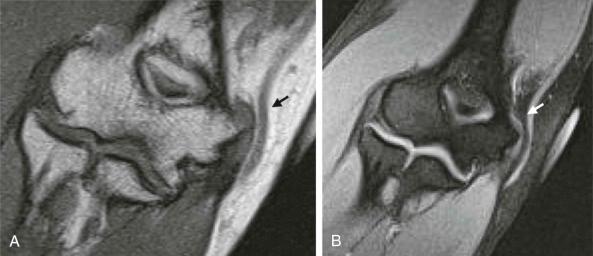
The ulnar nerve may sublux or dislocate out of the cubital tunnel in cases of simple decompression ( Fig. 108-8 ) or medial epicondylectomy. Adjacent vascular structures should also be assessed for patency and absence of damage. Excessive scar tissue can interfere with nerve function. The muscles innervated by the ulnar nerve should be evaluated for denervation changes. Infection or inflammatory changes may present with increased signal intensity on MRI in the area of surgery. Abscesses or seromas will be identified as rim-enhancing collections of fluid in the region on postcontrast MRI and as hypoechoic areas of fluid on ultrasonography.
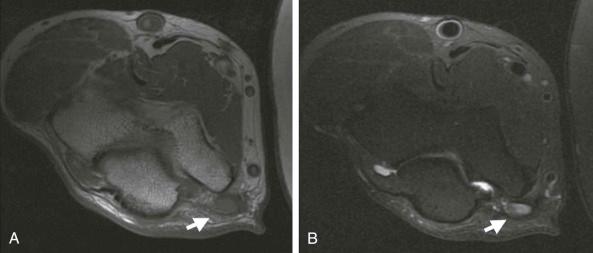
Become a Clinical Tree membership for Full access and enjoy Unlimited articles
If you are a member. Log in here